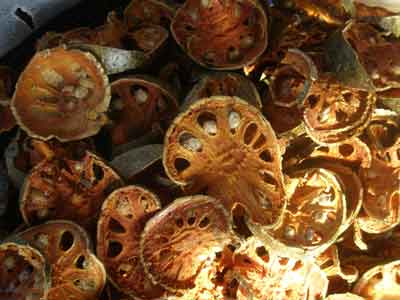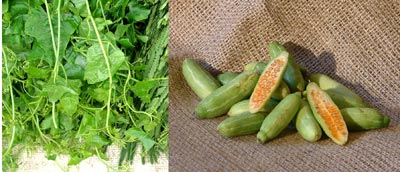Kencur is a plant similar to ginger but with a distinctive flavour. The rhizome is smaller and more shrivelled than that of ginger. It is used both medicinally and in the cuisine of much of the Indian Subcontinent and South East Asia, but not of Thailand where is it used only medicinally. It is sometimes erroneously referred to as lesser galangale.

Bael fruit; a close relative of the citrus. The fruit is about the size of, and has the appearance of a greyish-yellow orange with a thin woody rind. The floury pulp is pale orange in colour and has numerous seeds. Dried slices are soaked and boiled and the resulting liquid sweetened and drunk. Used for medicinal purposes.

Bael fruit; a close relative of the citrus. The fruit is about the size of, and has the appearance of a greyish-yellow orange with a thin woody rind. The floury pulp is pale orange in colour and has numerous seeds. Dried slices are soaked and boiled and the resulting liquid sweetened and drunk. Used for medicinal purposes.

Ivy gourd. A small crunchy gourd reminiscent of a gherkin, green ripening to red, popular in the cuisines of India, Thailand, Indonesia and other South East Asian countries. The shoots and leaves can also be eaten.
Sapodilla. A fruit which can be round or oval. Its thin skin is slightly rough and the flesh is dull, beige to terra cotta in colour and slightly granular with flat black seeds. Peel the skin away to reveal the apricot-coloured, honey-flavoured flesh. If it is eaten slightly under-ripe it may leave a residue of gum in the mouth. This can be dispelled by eating something fatty or wiping the lips with butter. One variety provides the gum for chewing gum.

Cassava. Manioc. Yuca. Fleshy, starchy tubers with tough brown skin and crisp white flesh, originally from Brazil but now widely cultivated. There are two types, sweet and bitter. Avoid the bitter one. Throughout the Amazon basin there are 26 varieties, each thriving under different conditions. The process of making it into flour or tapioca removes the toxins.